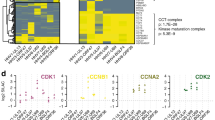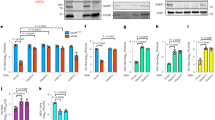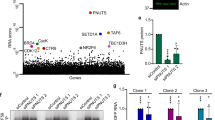Abstract
Adenovirus E1A proteins prepare the host cell for viral replication, stimulating cell cycling and viral transcription through interactions with critical cellular regulatory proteins such as RB1,2 and CBP3. Here we show that the E1A zinc-finger domain that is required to activate transcription of viral early genes binds to a host-cell multiprotein complex containing homologues of yeast Srb/Mediator proteins4,5. This occurs through a stable interaction with the human homologue of Caenorhabditis elegans SUR-2, a protein required for many developmental processes in the nematode6. This human Srb/Mediator complex stimulates transcription in vitro in response to both the E1A zinc-finger and the herpes simplex virus VP16 activation domains. Interaction with human Sur-2 is also required for transcription to be activated by the activation domain of a transcription factor of the ETS-family in response to activated mitogen-activated protein (MAP) kinase.
This is a preview of subscription content, access via your institution
Access options
Subscribe to this journal
Receive 51 print issues and online access
$199.00 per year
only $3.90 per issue
Buy this article
- Purchase on Springer Link
- Instant access to full article PDF
Prices may be subject to local taxes which are calculated during checkout




Similar content being viewed by others
References
Whyte, P., Williamson, N. M. & Harlow, E. Cellular targets for transformation by the adenovirus E1A. Cell 56, 67–75 (1989).
Zhu, L. et al. Growth suppression by members of the retinoblastoma protein family. Cold Spring Harbor Symp. Quant. Biol. 59, 75–84 (1994).
Arany, Z., Sellers, W. R., Livingston, D. M. & Eckner, R. E1A-associated p300 and CREB-associated CBP belong to a conserved family of coactivators. Cell 77, 799– 800 (1994).
Meyer, V. E. & Young, R. A. RNA polymerase II holoenzymes and subcomplexes. J. Biol. Chem. 273, 27757– 27760 (1998).
Myers, L. C. et al. The Med proteins of yeast and their function through the RNA polymerase II carboxy-terminal domain. Genes Dev. 12 , 45–54 (1998).
Singh, N. & Han, M. sur-2, a novel gene, functions late in the let-60 ras-mediated signaling pathway during Caenorhabiditis elegans vulval induction. Genes Dev. 9, 2251–2265 (1995).
Boyer, T. G. & Berk, A. J. Functional interaction of adenovirus E1A with holo-TFIID. Genes Dev. 7, 1810– 1823 (1993).
Webster, L. C. & Ricciardi, R. P. trans -Dominant mutants of E1A provide genetic evidence that the zinc finger of the transactivating domain binds a transcription factor. Mol. Cell. Biol. 11, 4287–4296 (1991).
Brauer, A. W., Oman, C. L. & Margolies, M. N. Use of o -phthalaldehyde to reduce background during automated Edman degradation. Analyt. Biochem. 137, 134–142 (1984).
Graham, F. L., Smiley, J., Russell, W. & Nairn, R. Characteristics of a human cell line transformed by DNA from human adenovirus type 5. J. Gen. Virol. 36, 59–74 (1977).
Flint, J. & Shenk, T. Adenovirus E1A protein: paradigm viral transactivator. Annu. Rev. Genet. 23, 141 –161 (1989).
Tassan, J.-P., Jaquenoud, M., Leopold, P., Schultz, S. J. & Nigg, E. Identification of human cyclin-dependent kinase 8, a putative protein kinase partner for cyclin C. Proc. Natl Acad. Sci. USA 92, 8871–8875 (1995).
Liao, S. M. et al. Akinase-cyclin pair in the RNA polymerase II holoenzyme. Nature 374, 193–196 ( 1995).
Rickert, P., Seghezzi, W., Shanahan, F., Cho, H. & Lees, E. Cyclin C/CDK8 is a novel CTD kinase associated with RNA polymerase II. Oncogene 12, 2631–2640 (1996).
Gold, M. O., Tassan, J.-P., Nigg, E. A., Rice, A. P. & Herrmann, C. H. Viral transactivators E1A and VP16 interact with a large complex that is associated with CTD kinase activity and contains CDK8. Nucleic Acids Res. 24, 3771–3777 (1996).
Jiang, Y. W. et al. Mammalian mediator of transcriptional regulation and its possible role as an end-point of signal transduction pathways. Proc. Natl Acad. Sci. USA 95, 8538–8543 (1998).
Greenblatt, J. RNA polymerase II holoenzyme and transcriptional regulation. Curr. Opin. Cell Biol. 9, 310–319 (1997).
Kaiser, K. & Meisterernst, M. The human general co-factors. Trends Biochem. Sci. 9, 342– 345 (1996).
Janknecht, R. & Nordheim, A. Gene regulation by Ets proteins. Biochem. Biophys. Acta 1155, 346– 356 (1993).
Faris, M., Kokot, N., Lee, L. & Nel, A. E. Regulation of interleukin-2 transcription by inducible stable expression of dominant negative and dominant active mitogen-activated protein kinase kinase kinase in jurkat T cells. Evidence for the importance of Ras in a pathway that is controlled by dual receptor stimulation. J. Biol. Chem. 271, 27366– 27373 (1996).
Denhardt, D. T. Signal-transducing protein phosphorylation cascades mediated by Ras/Rho protein in the mammalian cell: the potential for multiplex signalling. Biochem. J. 318, 729–747 (1996).
Sun, X. et al. NAT, a human complex containing Srb polypeptides that functions as a negative regulator of activated transcription. Mol. Cell 2, 213–222 (1998).
Cho, H. et al. Ahuman RNA polymerase II complex containing factors that modify chromatin structure. Mol. Cell. Biol. 18, 5355–5363 (1998).
Gu, W. et al. Anovel human SRB/MED-containing cofactor complex, SMCC, involved in transcription regulation. Mol. Cell 3, 97–108 (1999).
Ryu, S., Zhou, S., Ladurner, A. G. & Tijan, R. The transcriptional cofactor complex CRSP is required for activity of the enhancer-binding protein Sp1. Nature 397, 446–450 (1999).
Holstege, F. C. P. et al. Dissecting the regulatory circuitry of a eukaryotic genome. Cell 95, 717–728 (1998).
Mes-Masson, A. M., McLaughlin, J., Daley, G. Q., Paskind, M. & Witte, O. N. Overlapping cDNA clones define the complete coding region for the P210c-abl gene product associated with chronic myelogenous leukemia cells containing the Philadelphia chromosome. Proc. Natl Acad. Sci. USA 83, 9768– 9772 (1986).
Bryant, G. O., Martel, L. S., Burley, S. K. & Berk, A. J. Radical mutagenesis reveals TATA-box binding protein surfaces required for activated transcription in vivo. Genes Dev. 10, 2491–2504 (1996).
Acknowledgements
We thank R. Kornberg for anti-mMed7 antibody and P. Rickert for anti-Cdk8 and anti-cyclin C antibodies; M. Carey, W. Huang, S. Rundlett, S. Smale, J. Stevens and P. R. Yew for advice and comments; and C. Eng for technical assistance. This work was supported by the NIH. T.G.B. was initially supported by a postdoctoral fellowship from the California Division of the American Cancer Society.
Author information
Authors and Affiliations
Rights and permissions
About this article
Cite this article
Boyer, T., Martin, M., Lees, E. et al. Mammalian Srb/Mediator complex is targeted by adenovirus E1A protein . Nature 399, 276–279 (1999). https://doi.org/10.1038/20466
Received:
Accepted:
Issue Date:
DOI: https://doi.org/10.1038/20466
This article is cited by
-
The Mediator complex as a master regulator of transcription by RNA polymerase II
Nature Reviews Molecular Cell Biology (2022)
-
Regulation of the terminal maturation of iNKT cells by mediator complex subunit 23
Nature Communications (2018)
-
Transcription regulation by the Mediator complex
Nature Reviews Molecular Cell Biology (2018)
-
Crystal structure of human Mediator subunit MED23
Nature Communications (2018)
-
Dysregulation of the basal RNA polymerase transcription apparatus in cancer
Nature Reviews Cancer (2013)
Comments
By submitting a comment you agree to abide by our Terms and Community Guidelines. If you find something abusive or that does not comply with our terms or guidelines please flag it as inappropriate.



